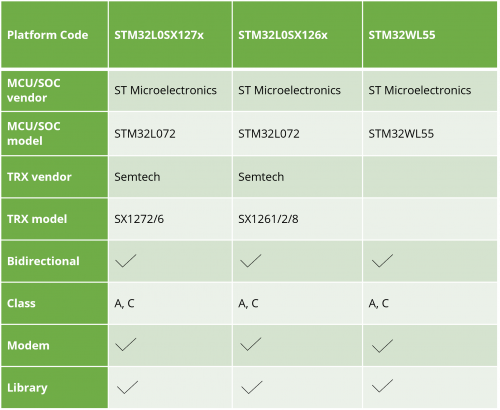The LoRaWAN® Stack is an ideal solution to equip devices in complex environments to communicate with wireless technology. In part 1 of our article, we covered the LoRaWAN® Stack features, the specifics of the STACKFORCE Stack compared to the open source variant, and the Protocol Stack Package. In part 2 of the article, we provide insight into the appropriate hardware that can be used to enable devices to communicate with LoRaWAN® and the options for certifying LoRaWAN® products.
Microcontroller, radio chips and System-on-Chip
The LoRaWAN® Stack has already been ported to different hardware platforms consisting of either a microcontroller (MCU) in combination with a radio chip (TRX), or a system-on-chip (SOC). The choice of hardware is currently limited to products from Semtech as the owner of LoRaWAN®. The only exception is the STM32WL family from ST Microelectronics. These are microcontrollers of the STM32 family, which additionally integrate a sub-GHz radio interface based on an SX126x radio chip from Semtech. The following table provides an overview of the hardware on which the LoRaWAN® Stack has already been successfully tested and used several times.

Hardware requirements
The stack includes a Hardware Abstraction Layer (HAL) that allows the stack to run on a specific hardware platform. The HAL attaches the following required hardware to the Protocol Stack itself:
- 1-2x timers
- 1x SPI (applies to dedicated transceiver)
- 2-4x GPIO (applies to and depends on dedicated transceivers)
- Software RF interface (applies to system-on-chip)
- AES encryption in hardware (if available and applicable)
- CRC calculation in hardware (if present and applicable)
Memory requirements:
The following code sizes indicate the memory requirements for typical LoRaWAN® applications with drivers and peripherals to use the stack as a "library" with the associated drivers, or alternatively the recommended amount of memory for a firmware when using the modem application. The values are only to be understood as reference points and are basically dependent on several factors, such as compiler, compiler configuration or hardware platform. In addition, the values explicitly do not consider any memory requirements of the application. RAM and flash can vary greatly due to maintenance or depending on the options or customizations selected.
Library only
- RAM: min. 8 kB
- Flash: min. 55-72 kB
Modem firmware
- RAM: min. 8 kB
- Flash: min. 128 kB
Product Certification – security for manufacturer and user
If you want to equip your devices with LoRaWAN® technology, you should also keep an eye on product certification. Certification offers users the security that the product will meet expectations in the best possible way over a long period of time and ensure interoperability. Similarly, in tenders, for example from network operators, device certification is often required, so applicants without certified end devices are not considered.
LoRaWAN® certification is available for members of the LoRa Alliance®. The LoRa Alliance® offers its members the LoRaWAN® Certification Test Tool (LCTT) to be able to prepare a certification by themselves, before the device is tested externally in a LoRaWAN® Test House. The advantage of the STACKFORCE LoRaWAN® Stack is that it can be ported to your own hardware by STACKFORCE as part of the porting service. This automatically guarantees passing the certification by a LoRaWAN® Test House. After successful certification of the product, the LoRa Alliance® offers all members the possibility to promote the certified end devices via the Alliance website in the LoRaWAN Certifiedcm Showcase for marketing purposes.
To be distinguished from the LoRaWAN® certification is the product certification. Depending on the country of use of the device, different requirements must be met. To support product certification according to the respective regional requirements, STACKFORCE's LoRaWAN® Stack offers an already integrated RF test function (Radio Tests), which can be activated via a special test mode. In this way, it can basically be recognized whether the product operates within the legal requirements in terms of radio technology, and a test center can award the test seal to the product.
You are not sure whether the LoRaWAN® technology is the right one for you? Then read more about the newcomer mioty® in our next Stack related article or contact us for more information.

